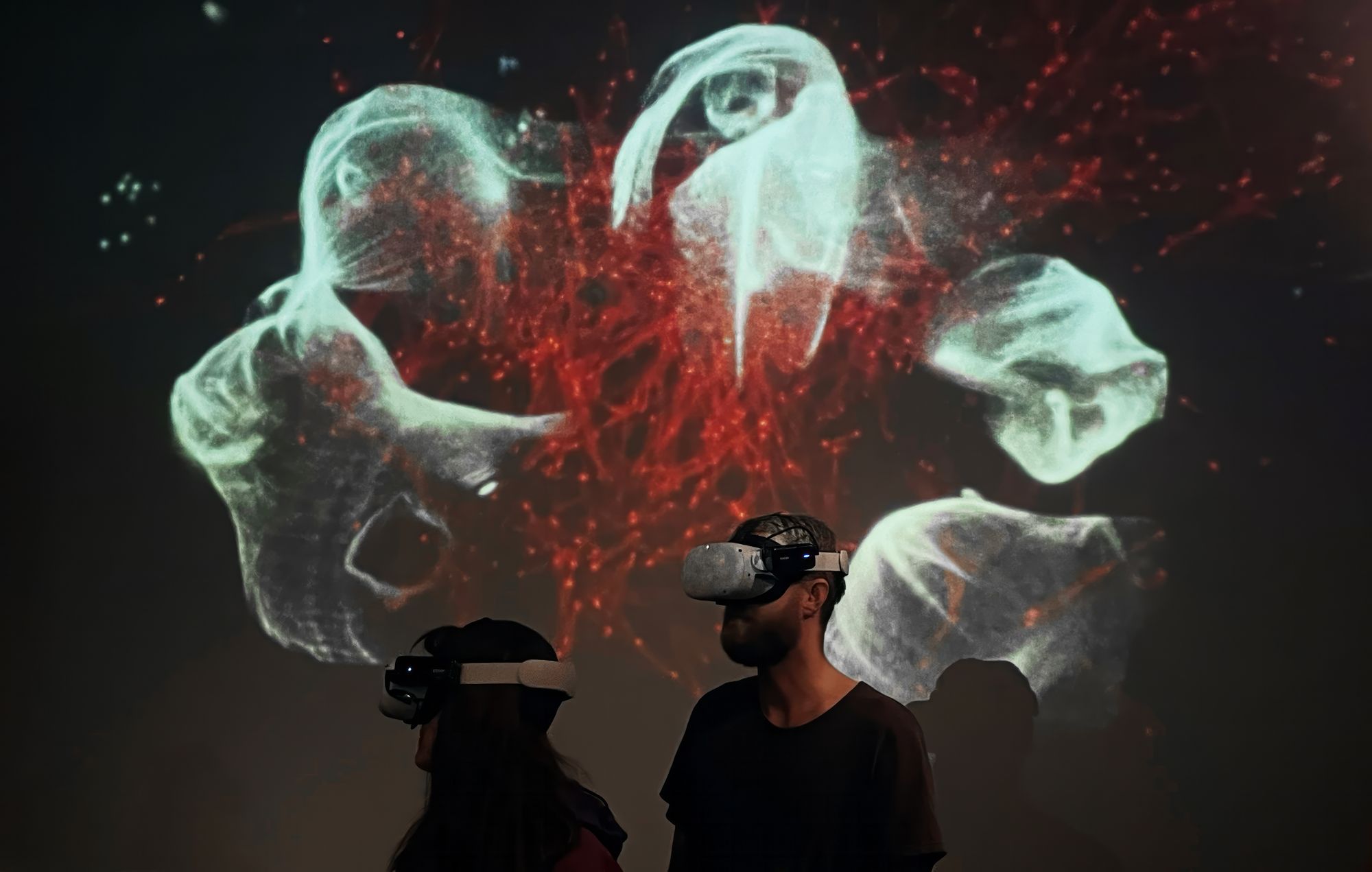Garden of Ghost Flowers at the Nobel Prize Museum

Last weekend, we showed the Garden of Ghost Flowers at the Nobel Prize Museum as a part of their exhibition on fungi in art and science. Big thanks to the team at the museum and to curator Britt van der Poel for inviting us.
Garden of Ghost Flowers is an interactive performance in virtual reality created with co-artists Lundahl & Seitl. The work was previously supported by and shown at the STRP Festival 2022 in Eindhoven and Magasin III in Stockholm. For the Nobel Prize Museum, we restructured the piece for a smaller, workshop-like format, followed by a conversation about the experience.
You are led into a room and invited to sit down on the floor with the back of another participant. A VR headset is placed on your head. Inside, you see nothing but darkness. A guide leads you on a short breathing exercise before asking you to, on their mark, make a sound. As you let your voice out, you see it visualised in front of you, as well as the voices of the other participants.
You stand up and let your visualised voice intermingle with those of the others, and in these vocal intersections, something starts to grow. Strange, fungal shapes, primitive life forms, small at first but larger the more you feed it from your vocal cords. The ghost flower is a virtual being living off the timbre of your voices. The flower created by each group is unique, depending on how they use their voices together.
Ghost Flowers at STRP Festival.
The Nobel Prize Museum was an ideal context to show this work. The work has many scientific aspects, both through the use of genetic algorithms and through the mechanics behind the collaborative process of giving nutrition to the virtual ecosystem. We use VR not to transport the audience to another world but to visualise what is already present between them. In this sense, the headset becomes an instrument through which we see what is already there.
Thank you to everyone who participated. It was rewarding to hear your reflections afterwards, and your thoughts will help us take the work further. We will let you know next time it’s shown.
For STRP, we were invited to write an essay about the themes that we explore, which you can read here:

Notes on umwelt-hacking in the Garden of Ghost Flowers
Before we start, I want to test something. Take a deep breath. On my mark, use your voice to make a sound -any sound. One… Two… Three. Feel the vibration of your voice in your body. Listen to the reverberations of the sound in the space around you. Now the sound is over. It has passed its limits in time and space, and ceased to be. You cannot feel or hear it, only remember it.
In books 10 and 11 of his Confessions, Saint Augustine meditates on how memories are formed, how they form us, and how they mediate our existence in time. He uses the act of singing to illustrate this relationship: without memory, I would experience a hymn not as a hymn but as separate, disconnected sounds, without the temporal shifts that create variance, emotion, and intensity. The ability of a sound to make a lasting impression in my mind allows me to experience the hymn. My memories of other hymns allow me a degree of anticipation of what sounds will come next, and the potential for participating in the singing.
We hear the sound of the hymn through our ears, and perceive other sensory inputs through other senses. Saint Augustine realises that sensory input is foundational for memory, and our experience of the world. “I come to the fields and vast palaces of memory, where are stored the innumerable images of material things brought to it by the senses. ...if the images were not there I could not so much as speak of the things.” The specific design of these senses defines what information they transmit, and the structure and capabilities of our internal “fields and vast palaces of memory” defines how this information is experienced. If I have never encountered a hymn before, hearing one might be a fascinating experience, but not one I can anticipate or participate in.
Umwelt, or ‘self-world', is a term by the 19th-century biologist Jakob von Uexkull, describing a particular being's unique experience of the world as a result of their specific sensory apparatuses. Everything its senses allow it to sense. Our umwelt is not the same as that of a dog, our olfactory worlds are incomparable, and they can only see a few colors. Birds and insects can see far more colours than we can, and bumblebees can sense a flower's electromagnetic field through hairs on their legs.
Our human umwelt is mediated by and expanded through technology, the word “technology” here used in the broadest sense, including all human techne from tools to knowledge and practices. The expansion is twofold. On one hand, it consists of new tools providing new inputs for our sensory apparatuses. On the other, it consists of an expansion of our interior experiential capabilities, the sensibilities of our “fields and vast palaces of memory,” to be able to process this input. Before the invention of the microscope, the microscopic world was not a part of ours, unknown and outside our reach. Slowly we learned to understand this strange world, laying the foundation for contemporary medicine and biology. Today, I use tools of telepresence to shatter spatial limitations and extend my senses all over the world, but my internal experiential capabilities are not accustomed to this new spatiality, confused and fatigued I drift from one virtual frame to the next.
No tool is neutral. Any man made tool is, to varying degrees designed, which defines in what way they shape our umwelt. In this design is embedded a certain idea of how the tool should form the human, an idea that in many ways is limited by the existing internal experiential capabilities of the designer. It is hard to design for that one does not know. One simple example is crash-test dummies, overwhelmingly designed after the male body they result in car designs with a much higher chance of injury for female drivers.
The philosopher Yuk Hui has written on how our current technological progress is based on one particular cosmology, i.e. a view of the world and the human. He calls for a ‘technodiversity’, not diversity within technology but a diversity of technologies, as a response to the current philosophical monoculture underpinning contemporary technology. In his own words, “Without technodiversity, we only have homogenous ways of dealing with nonhuman agencies and the world itself—as if homogeneous equals universal.” The world is not homogenous. A technological monoculture results in disadvantageous ways for us to understand and interact with it.
“It matters what matters we use to think other matters with”, as famously said by Donna Haraway. Since the tools we use define our umwelt, we ought to be concerned if our current toolset is ill-adapted to the real world. The neurologist David Eaglemann has coined the term umwelt hacking: the conscious act of constructing new tools to expand our umwelts, adding new matter to sense new matters of the world. What these expansions entail, we cannot know, as they are not currently a part of us.
This expansion must include both our external sensory apparatuses and our internal experiential capabilities. Contemporary umwelt hacking, loosely contained within the vague umbrella of transhumanism, is overly focused on the external side of this expansion. If we invented a sensory extension making it possible for me to sense the electromagnetic fields of flowers, what would I do with this information? Without a language to understand this experience, it would be reduced to a gimmick, a cool toy to show at tech fairs, soon forgotten. A sense has no use if we don't know how to understand what is gained from it.
In 1821, the Cherokee intellectual Sequoyah finished his design of syllabary created for his people’s language. He was inspired by the writing systems used by European settlers, whose alphabets had developed over thousands of years, a process he completed in a decade. A mere repurposing of the Latin alphabet would have been ill-accustomed to the specific shape of the Cherokee language. Instead, Sequoyah created a new tool for this existing experiential capability, a new matter to sense with, a material dimension to these “fields and vast palaces of memory,” allowing it to transcend the muck of immediacy and no longer rely solely on the capricious traces of spoken words. The Cherokee syllabary was quickly adopted. A generation later their tribe's literacy rate was almost total, vastly exceeding that of the surrounding Europeans.
Our current technology has given us the tools, the syllabary of sorts, to sense things far outside the scope of previous human experience. But we seem to be lacking the internal experiential capabilities necessary to understand these new inputs. Maybe what is required is not as much the addition of new technological senses, but of new languages better suited to speak about that which we can already feel, new internal capabilities allowing us to experience what technology already allows us to sense.
Loafe with me on the grass, loose the stop from your throat,
Not words, not music or rhyme I want, not custom or lecture, not even the best,
Only the lull I like, the hum of your valvèd voice.
🌱